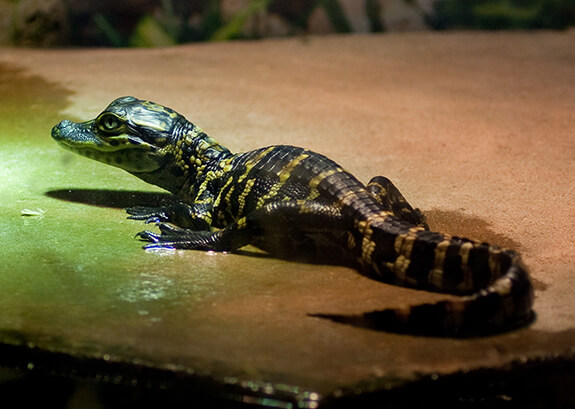Pet Alligators (Allgatoridae): What You Need To Know
The alligators and the caimans, are different from the crocodiles in that when the mouth is closed, the teeth of the lower jaw are not visible. The are covered by the upper jaw and there is a groove provided in the upper jaw for the large fourth tooth of the lower jaw. It does happen, though, that alligators and caimans that have not bred true to type do exhibit jaw deformities with the teeth disposed to the outside.

All Alligatoridae are severely endangered by the hunt for skins for the leather industry and therefore are protected by the Washington Endangered Species Agreement. Of the whole family of alligators, only the dwarf caiman is a candidate for keeping in a terrarium. Though not a lizard, it is included because it may be of interest to some hobbyists.
Differences between sexes: Among Alligatoridae raised together, as a rule, the male animals are larger than the females and their skull is bigger. Among lizards that have not been raised together differentiations between the sexes on the basis of these elements is scarcely possible because they depend on so many factors. Definite determination that the animal in question is male can only be established by palpation of the penis. For this the dwarf caiman must have attained a body length of at least 32 inches (80 cm).
Reproduction: Reproduction of the dwarf caiman takes place in the months between December and April. During this time the male gives out threatening guttural sounds. Mating takes place at night. Before egg-laying — in the months from May to August — the female builds a nest from plant stems, leaves, and similar material. The warmth given off by the decaying nest materials incubates the eggs. When kept in a terrarium, the caiman lays her eggs in a sand pit, too; the hard-shelled eggs must then be transferred to an incubator. The maturation time is 100 to 115 days at 82° to 86°F (28 to 30°C).
Dwarf caiman*
Paleosuchuspalpebrosus (Cuvier, 1807)
Endangered species regulation: WA II C2 Total length: 56 inches (140 cm).
Head-torso length: 28 inches (70 cm).
Distribution and Description: Northern South America, southward to latitude 20.
Habitat: Shallows, but also to some extent fast-moving water, even areas of rapids. Identifying characteristics: Iris chestnut brown, upper eyelid hardened, no ridge between the eyes.
Behavior: Solitary without notable territorial behavior. Definitely recognizes different people and connects specific experiences with them.
Maintenance: Shallow-water terrarium, with a land portion as a shelf. The terrarium size will change because the space requirements increase with growth. For three caimans in the first year (total length to 20 inches [50 cm]): 28 x 28 x 20 inches (70 x 70 x 50 cm); water depth 2 inches (5 cm). Second to fourth year (total length to 30 inches [75 cm)): 48 x 36 x 20 inches (120 x 90 x 50 cm), water depth 4 inches (10 cm). Fifth to seventh year (total length to 40 inches [ 100 cm]): 60 x 44 x 28 inches (150 X 110 X 70 cm) water depth 6 inches (15 cm). For a breeding pair: 80 x 80 x 40 inches (200 x 200 x 100 cm), water depth of 20 inches (50 cm). Only when there are hanging epiphytes should terrariums be higher than specified.
Decorations: Stones, stumps, epiphytic-plants from the rain forests of Central and South America. For breeding, plant material for nest building.
Temperature: Day and night, 77° to 86°F (25-30°C); Water: 77°F (25°C).
Humidity: 70 to 90 percent.
Food: About a fifth of a mouse or a rat, otherwise freshwater fish. In the wild, young animals also eat snails and freshwater shrimp.



Leave a Reply